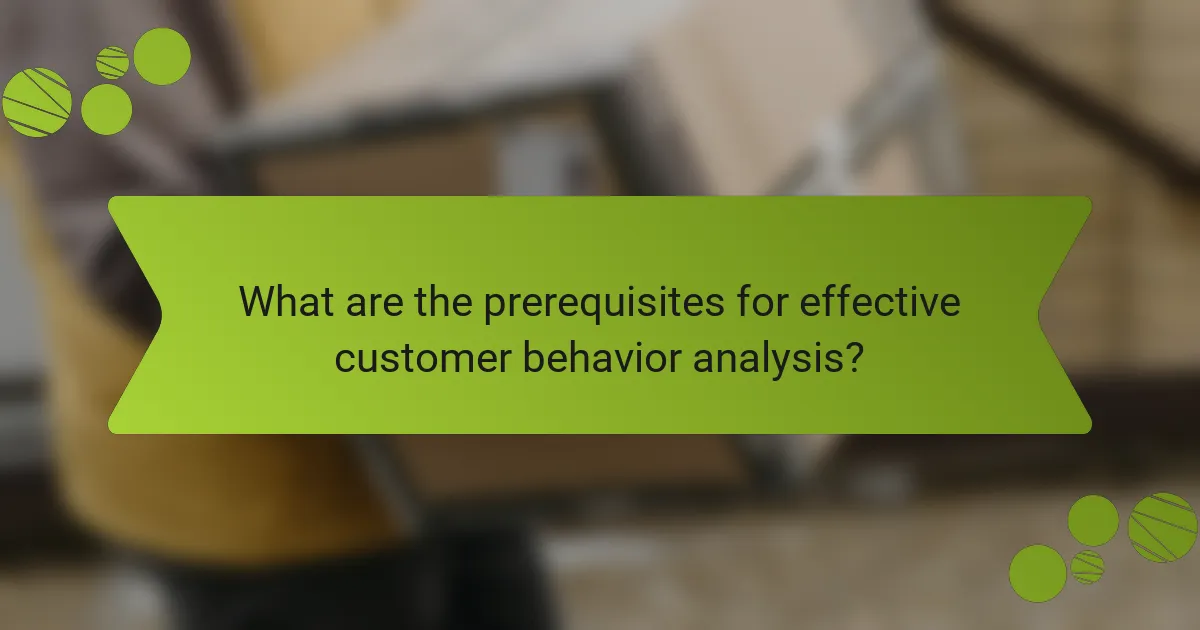In the competitive landscape of e-commerce, understanding customer behavior is crucial for success. By utilizing effective tools and techniques, businesses can gain valuable insights into user interactions, preferences, and purchasing decisions. This analysis not only helps optimize marketing strategies but also enhances the overall user experience, driving engagement and sales.

What are effective tools for e-commerce customer behavior analysis?
Effective tools for e-commerce customer behavior analysis include platforms that track user interactions, provide insights into customer journeys, and help optimize marketing strategies. These tools enable businesses to understand how customers navigate their sites, what influences their purchasing decisions, and how to enhance user experience.
Google Analytics
Google Analytics is a powerful tool that tracks website traffic and user behavior. It provides insights into user demographics, acquisition channels, and conversion rates, allowing businesses to identify which marketing efforts are most effective.
To make the most of Google Analytics, set up goals to track specific actions, such as purchases or newsletter sign-ups. Regularly review reports on user engagement and behavior flow to optimize your site layout and content.
Hotjar
Hotjar offers heatmaps, session recordings, and feedback polls to visualize user behavior on your website. Heatmaps show where users click, scroll, and move, helping identify areas of interest or confusion.
Utilize Hotjar’s feedback tools to gather direct insights from users about their experiences. This qualitative data can complement quantitative metrics from other tools, providing a fuller picture of customer behavior.
Crazy Egg
Crazy Egg provides heatmaps and A/B testing features to analyze how users interact with your site. Its visual reports help identify which elements attract attention and which may need redesigning to enhance usability.
Implement A/B tests to compare different versions of a page and determine which performs better in terms of user engagement and conversions. This iterative approach can significantly improve site effectiveness over time.
Mixpanel
Mixpanel focuses on tracking user interactions with products and features rather than just page views. It allows businesses to analyze customer journeys in detail, providing insights into user retention and engagement.
Use Mixpanel’s cohort analysis to segment users based on behavior, enabling targeted marketing strategies. This tool is particularly useful for SaaS and subscription-based e-commerce models.
Adobe Analytics
Adobe Analytics offers advanced analytics capabilities, including real-time data processing and predictive analytics. It helps businesses understand customer behavior across multiple channels, integrating data from online and offline sources.
Consider Adobe Analytics if your business requires deep insights and advanced segmentation. Its robust features are ideal for larger organizations with complex data needs, but it may come with a higher cost compared to other tools.

How can e-commerce businesses leverage customer insights?
E-commerce businesses can leverage customer insights to tailor their marketing efforts, enhance user experiences, and provide better product recommendations. By analyzing customer behavior and preferences, companies can create targeted strategies that drive engagement and sales.
Personalized marketing strategies
Personalized marketing strategies involve customizing promotions and communications based on individual customer data. This can include targeted emails, personalized product suggestions, and tailored advertisements that resonate with specific customer segments.
To implement effective personalized marketing, businesses should collect data on customer preferences, purchase history, and browsing behavior. Utilizing tools like CRM systems and analytics platforms can help in segmenting customers and automating personalized outreach.
Improved user experience
Improving user experience is crucial for retaining customers and increasing conversion rates. Insights into customer behavior can help identify pain points in the shopping journey, allowing businesses to streamline processes and enhance website usability.
Consider conducting usability tests and gathering feedback to understand how customers interact with your site. Simple changes, such as optimizing page load times and simplifying navigation, can significantly improve the overall shopping experience.
Enhanced product recommendations
Enhanced product recommendations utilize customer insights to suggest items that align with individual preferences and past purchases. This can lead to increased sales and customer satisfaction as shoppers discover products they are likely to buy.
Implementing recommendation algorithms, such as collaborative filtering or content-based filtering, can help personalize suggestions. Regularly updating these algorithms based on new customer data ensures that recommendations remain relevant and effective.

What techniques are used in customer behavior analysis?
Customer behavior analysis employs various techniques to understand how consumers interact with e-commerce platforms. These methods help businesses tailor their strategies to enhance user experience and drive sales.
Segmentation analysis
Segmentation analysis involves dividing customers into distinct groups based on shared characteristics such as demographics, purchasing behavior, or preferences. This technique allows businesses to target specific segments with tailored marketing strategies, improving engagement and conversion rates.
For effective segmentation, consider factors like age, location, and buying habits. Tools like Google Analytics or customer relationship management (CRM) systems can facilitate this process by providing insights into customer data.
Customer journey mapping
Customer journey mapping visualizes the steps customers take from awareness to purchase. This technique helps identify pain points and opportunities for improvement throughout the shopping experience.
To create a customer journey map, gather data from various touchpoints such as website visits, social media interactions, and customer service inquiries. This holistic view enables businesses to enhance user experience and increase customer satisfaction.
A/B testing
A/B testing compares two versions of a webpage or marketing material to determine which performs better. This technique is essential for optimizing elements like headlines, images, and call-to-action buttons based on real user behavior.
When conducting A/B tests, ensure you have a clear hypothesis and sufficient traffic to achieve statistically significant results. Tools like Optimizely or Google Optimize can assist in running these tests effectively.
Heat mapping
Heat mapping visually represents where users click, scroll, and spend time on a webpage. This technique provides insights into user engagement and helps identify areas for improvement in layout and design.
Using heat mapping tools like Hotjar or Crazy Egg, businesses can analyze user behavior to optimize website elements, ensuring that critical information is easily accessible and engaging for visitors.

What are the key metrics for analyzing customer behavior?
Key metrics for analyzing customer behavior include conversion rate, cart abandonment rate, customer lifetime value, and average order value. These metrics provide insights into how customers interact with an e-commerce platform, helping businesses optimize their strategies for better performance.
Conversion rate
The conversion rate measures the percentage of visitors who complete a desired action, such as making a purchase. A higher conversion rate indicates effective marketing and website design, while a lower rate may signal issues that need addressing.
To calculate the conversion rate, divide the number of conversions by the total number of visitors and multiply by 100. For example, if 1000 visitors come to your site and 50 make a purchase, your conversion rate is 5%.
Improving conversion rates can involve A/B testing different elements on your site, such as call-to-action buttons or product descriptions, to see what resonates best with your audience.
Cart abandonment rate
The cart abandonment rate reflects the percentage of shoppers who add items to their cart but leave without completing the purchase. A high abandonment rate can indicate friction in the checkout process or lack of trust in the site.
To calculate this rate, divide the number of completed purchases by the number of initiated checkouts and subtract from 1. For instance, if 200 carts are created and 50 purchases are made, the abandonment rate is 75%.
Strategies to reduce cart abandonment include simplifying the checkout process, offering guest checkout options, and providing clear shipping information upfront.
Customer lifetime value
Customer lifetime value (CLV) estimates the total revenue a business can expect from a single customer over their entire relationship. Understanding CLV helps businesses allocate marketing resources effectively and identify high-value customers.
To calculate CLV, multiply the average purchase value by the average purchase frequency and the average customer lifespan. For example, if a customer spends $50 per purchase, buys twice a year, and remains a customer for 5 years, their CLV would be $500.
Focusing on increasing CLV can involve enhancing customer service, creating loyalty programs, and personalizing marketing efforts to encourage repeat purchases.
Average order value
Average order value (AOV) measures the average amount spent by customers per transaction. This metric is crucial for understanding purchasing behavior and can guide pricing strategies and promotional efforts.
To calculate AOV, divide total revenue by the number of orders. For instance, if your total revenue is $10,000 from 200 orders, your AOV is $50.
Increasing AOV can be achieved through upselling, cross-selling, or offering discounts on minimum purchase amounts, encouraging customers to spend more per transaction.

What are the prerequisites for effective customer behavior analysis?
Effective customer behavior analysis requires a solid foundation of data collection, analytical tools, and a clear understanding of customer objectives. Organizations need to ensure they have the right technology and processes in place to gather and interpret data accurately.
Data collection methods
Data collection methods are essential for gathering insights into customer behavior. Common techniques include surveys, website analytics, transaction records, and social media monitoring. Each method has its strengths; for example, surveys can provide qualitative insights while website analytics offer quantitative data.
When choosing data collection methods, consider the target audience and the type of information needed. A combination of methods often yields the best results, allowing for a more comprehensive understanding of customer preferences and behaviors. For instance, integrating feedback from surveys with website analytics can reveal why customers behave a certain way online.
Integration of analytics tools
Integrating analytics tools is crucial for synthesizing data from various sources into actionable insights. Tools like Google Analytics, CRM systems, and specialized e-commerce platforms can help businesses track customer interactions and behaviors across different channels. Proper integration ensures that data flows seamlessly, providing a holistic view of customer journeys.
When implementing analytics tools, prioritize those that can easily connect with existing systems and provide real-time insights. Regularly review the effectiveness of these tools and adjust as necessary to keep pace with changing customer behaviors. Avoid using too many disparate tools, as this can lead to data silos and complicate analysis.

How do e-commerce platforms compare in customer behavior analysis capabilities?
E-commerce platforms vary significantly in their customer behavior analysis capabilities, impacting how businesses understand and respond to consumer actions. Key differences include the types of analytics tools offered, data integration options, and the depth of insights available.
Key features of customer behavior analysis tools
Customer behavior analysis tools typically include features such as tracking user interactions, analyzing purchase patterns, and providing demographic insights. These tools can help businesses identify trends, optimize marketing strategies, and enhance user experience. Look for platforms that offer real-time analytics, customizable dashboards, and integration with other marketing tools.
Comparative effectiveness of popular e-commerce platforms
Popular e-commerce platforms like Shopify, WooCommerce, and Magento each have unique strengths in customer behavior analysis. Shopify excels with its built-in analytics and user-friendly interface, while WooCommerce offers extensive customization options through plugins. Magento, on the other hand, provides robust data handling capabilities suitable for larger enterprises.
Considerations when choosing a platform
When selecting an e-commerce platform for customer behavior analysis, consider factors such as your business size, budget, and specific analytical needs. Smaller businesses may benefit from user-friendly platforms like Shopify, while larger organizations might require the advanced features of Magento. Additionally, assess the platform’s ability to integrate with existing tools and its scalability for future growth.
Common pitfalls in customer behavior analysis
One common pitfall in customer behavior analysis is relying solely on surface-level metrics, such as page views, without understanding the context behind them. Another mistake is neglecting to segment data, which can lead to misleading conclusions. Ensure you analyze data comprehensively and consider customer segments to gain actionable insights.








